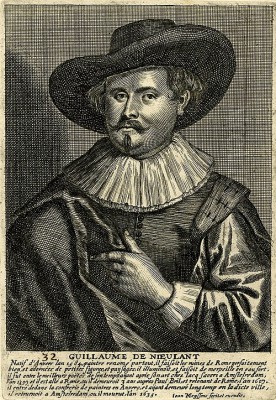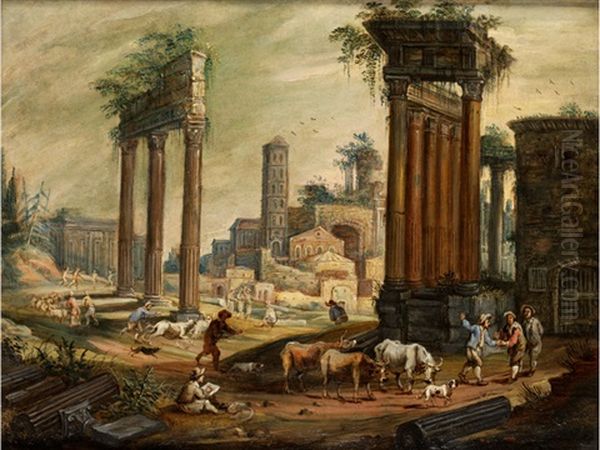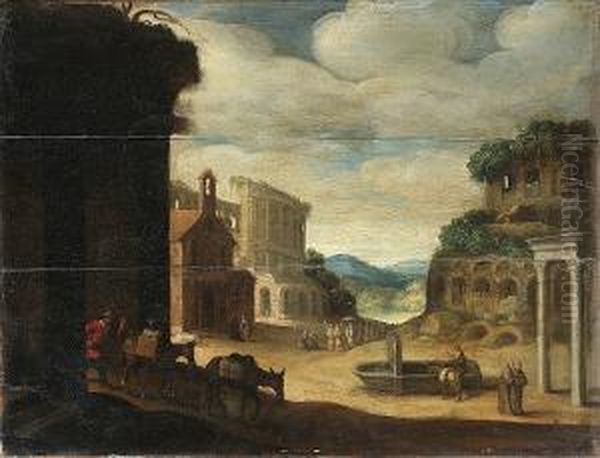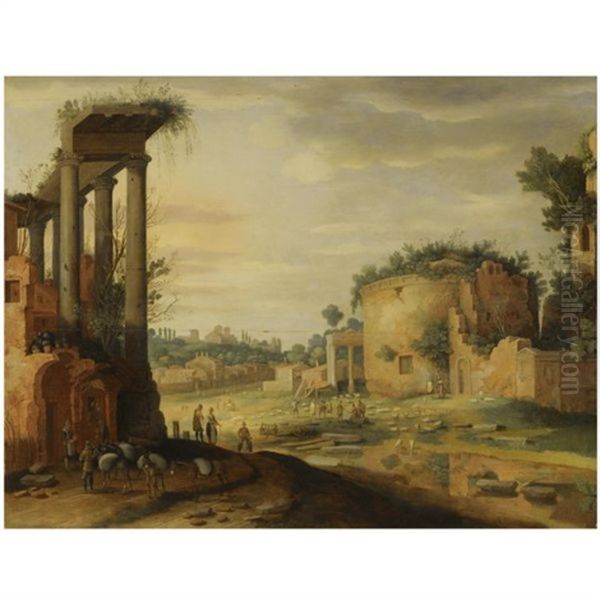
Willem van Nieulandt the Younger stands as a fascinating figure in the art history of the Low Countries during the Dutch Golden Age. Born into a family deeply rooted in artistic pursuits, he navigated the cultural landscapes of Antwerp, Amsterdam, and Rome, leaving behind a legacy as a painter, engraver, and even a playwright. His work, particularly his evocative depictions of Roman ruins and Italianate landscapes, bridges Flemish traditions and the burgeoning Dutch school, offering a unique perspective shaped by his travels and diverse training. Active during a period of immense artistic innovation and societal change, Van Nieulandt carved a distinct niche for himself, celebrated for his technical skill and his contribution to the enduring European fascination with classical antiquity.
Family Heritage and Early Life in Antwerp and Amsterdam
Willem van Nieulandt the Younger was born in Antwerp in 1584. He hailed from a notable Flemish family with established roots in the city; his lineage can be traced back to Jacob van Nieulandt, recorded as a citizen of Antwerp. Willem's father, Adriaen van Nieulandt the Elder (c. 1560–1601), was not only an artist but also a merchant dealing in quills. Seeking religious freedom, Adriaen, a Protestant, relocated his family from the predominantly Catholic Spanish Netherlands (Antwerp) to the more tolerant Dutch Republic. They settled in Amsterdam around 1589, where Adriaen became a citizen in 1594.
This move placed the young Willem in the vibrant, rapidly growing metropolis of Amsterdam, a major center of trade and culture. The Van Nieulandt family was thoroughly immersed in the arts. Willem's uncle, also named Willem van Nieulandt (the Elder, c. 1560–1626), was an artist and writer. Furthermore, Willem the Younger had two brothers who also pursued artistic careers: Adriaen van Nieulandt the Younger (1587–1658) and Jacob van Nieulandt (1593/94–1634). This familial environment undoubtedly fostered Willem's own artistic inclinations from a young age. In 1606, Willem married Anna Hustaert (d. 1629) in Amsterdam. Together they had several children, including Constantijn (baptized 1607), Adriana (baptized 1610), and Abigael (baptized 1614), ensuring the continuation of the family line in their adopted city.
Artistic Apprenticeship and Formative Influences

Willem van Nieulandt the Younger received a thorough artistic education in Amsterdam, apprenticing with several respected masters. Initially, he may have studied briefly with Jacob Savery (c. 1566–1603), a painter and etcher known for his landscapes and animal studies, before Savery's death during a plague outbreak. Some sources also suggest a connection to Jacob's more famous brother, Roelant Savery (1576–1639), known for his fantastical landscapes and detailed floral still lifes, though Roelant left Amsterdam for Prague around 1604.
More definitively documented are his apprenticeships under Pieter Isaacsz (1569–1625) and Frans Badens (c. 1571–1618). Isaacsz, Danish-born but active in Amsterdam, was a significant history painter and portraitist, known for his elegant style and smooth finish, traits that seem to have influenced Van Nieulandt's own refined technique. Badens, also an Amsterdam-based history and figure painter, further honed Willem's skills in depicting narrative scenes. This training provided Van Nieulandt with a solid foundation in the prevailing styles of late Mannerism and the emerging early Baroque sensibilities prevalent in Amsterdam at the turn of the 17th century, equipping him with the technical prowess necessary for a successful career.
The Transformative Italian Sojourn
Like many ambitious Northern European artists of his time, Willem van Nieulandt the Younger embarked on a journey to Italy to study art and antiquity firsthand. Around 1601 or 1602, he traveled to Rome, the ultimate destination for artists seeking inspiration from classical ruins and Renaissance masterpieces. This period proved immensely influential, shaping the primary themes and style of his mature work. In Rome, he immersed himself in the city's artistic environment and ancient monuments.
Crucially, during his Roman stay (which lasted until about 1604 or 1605), Van Nieulandt entered the workshop of Paul Bril (1554–1626). Bril was a highly successful Flemish painter who had settled in Rome and become one of the leading landscape artists there, specializing in idealized Italianate landscapes often incorporating classical ruins and biblical or mythological figures. Working with Bril exposed Van Nieulandt directly to the practice of depicting Roman topography and ancient architecture, subjects that would become central to his own oeuvre. He absorbed Bril's approach to landscape composition, light, and the romantic rendering of antiquity. During his time in Rome, Willem became known among the local and international artist community by the Italianized name "Guglielmo Terranova." His standing was recognized through his membership in the prestigious Accademia di San Luca, Rome's official academy of artists.
Return North: Antwerp Interlude and Playwriting

After his formative years in Italy, Willem van Nieulandt the Younger did not immediately return to Amsterdam. Instead, he traveled back north via Antwerp, the city of his birth, arriving around 1605 or 1606. In 1606, he was registered as a master in the Antwerp Guild of Saint Luke, the city's powerful artists' guild. This suggests an intention to establish himself professionally in the bustling artistic center of Flanders.
His time in Antwerp was marked not only by painting and engraving but also by a notable engagement with literature and theatre. Van Nieulandt became active as a playwright, writing several tragedies in Dutch, including works like Saul and Jerusalem Verwoest (Jerusalem Destroyed). He was associated with the local chambers of rhetoric (rederijkerskamers), societies that promoted poetry and drama. His plays were performed, and he gained recognition in Antwerp's literary circles. One notable commission was a tragedy written for Gaspar Duarte, a prominent Antwerp merchant of Portuguese Sephardic origin who was also a known art collector and patron. This period highlights Van Nieulandt's versatility and his participation in the rich cultural life of Antwerp, which, despite political and economic challenges, remained a major artistic hub, home to giants like Peter Paul Rubens (1577–1640).
Later Career in Amsterdam
While the exact timeline of his movements can be debated, Willem van Nieulandt the Younger eventually returned to Amsterdam, the city where his family had settled and where he had received his initial training. Sources suggest he may have been back and forth, but he appears to have settled more permanently in Amsterdam by the late 1620s, remaining there until his death around 1635.

In Amsterdam, he continued his artistic practice, focusing primarily on the themes and styles developed during his Italian sojourn and Antwerp period. He likely found a receptive market for his Italianate landscapes and detailed views of Roman ruins among the city's affluent merchant class. Amsterdam's art market was booming, characterized by a high degree of specialization. Van Nieulandt's particular expertise in Roman views catered to the growing taste for classical subjects and souvenirs of the Grand Tour, even among those who had not traveled themselves. His clients may have included conservative patrons, perhaps including fellow immigrants from the Southern Netherlands or their descendants, who appreciated his refined technique and elegant compositions, reminiscent of Flemish traditions yet infused with Roman grandeur. He continued to produce both paintings and engravings, contributing to the diverse artistic output of the Dutch metropolis during its Golden Age, alongside contemporaries working in various genres, from the historical narratives of Pieter Lastman (1583–1633) to the emerging genius of Rembrandt van Rijn (1606–1669).
Artistic Style: Flemish Detail Meets Italianate Vision
Willem van Nieulandt the Younger's artistic style is a distinctive blend of his Northern European training and his Italian experiences. His grounding in the workshops of Pieter Isaacsz and Frans Badens instilled in him a meticulous attention to detail and a smooth, refined finish, characteristic of late Mannerist and early Baroque painting in the Low Countries. This technical precision is evident throughout his work, from the rendering of architectural elements to the depiction of small figures populating his scenes.
However, his time in Rome, particularly under Paul Bril, fundamentally shaped his thematic focus and approach to landscape. He adopted the Italianate manner, characterized by idealized representations of the Italian countryside, often bathed in a warm, golden light. His compositions typically feature expansive views, carefully structured depth, and a harmonious balance between natural elements and architectural features. While influenced by Bril, Van Nieulandt developed his own recognizable style, often featuring slightly cooler palettes and a precise, almost graphic delineation of forms, perhaps reflecting his skills as an engraver. His work sits comfortably within the first generation of Dutch Italianate painters, artists who brought the light and landscapes of Italy into Northern European art, paving the way for later practitioners like Cornelis van Poelenburch (1594/95–1667) and Bartholomeus Breenbergh (1598–1657).
The Allure of Roman Ruins: A Defining Theme
The most characteristic and enduring aspect of Willem van Nieulandt the Younger's oeuvre is his fascination with the ruins of ancient Rome. He produced numerous paintings and engravings depicting famous sites like the Roman Forum, the Colosseum, the Palatine Hill, and various temples and arches. These were not mere topographical records; Van Nieulandt often composed his views imaginatively, sometimes combining elements from different locations into a picturesque arrangement known as a capriccio.

His depictions capture the grandeur of the decaying monuments, often contrasting them with the contemporary life unfolding around them – shepherds with their flocks, travelers resting, or artists sketching. This juxtaposition evokes themes of the passage of time, the transience of human endeavors (vanitas), and the enduring power of classical civilization. His interest coincided with a broader Renaissance and Baroque fascination with antiquity, fueled by archaeological discoveries and scholarly study. Van Nieulandt's works catered to this interest, providing evocative visualizations of Rome's past glory. His detailed renderings of architectural fragments, crumbling walls, and overgrown structures showcase both his observational skills, likely honed through sketches made in Rome, and his ability to imbue these scenes with a sense of romantic melancholy. His approach can be compared to that of his master Paul Bril, but also anticipates the more atmospheric ruin paintings of later Italianate artists.
Engravings and Literary Pursuits
Beyond his significant output as a painter, Willem van Nieulandt the Younger was also a prolific engraver and etcher. Printmaking was a crucial medium in the 17th century for disseminating artistic ideas and images to a wider audience. Van Nieulandt produced numerous prints, many of which reproduced his own drawings and paintings of Roman landscapes and ruins. He also created engravings after designs by other artists, most notably a series of Roman views based on drawings by Paul Bril.
These prints further cemented his reputation as a specialist in Roman subjects and made his popular compositions accessible to collectors who could not afford paintings. His graphic work displays the same precision and clarity found in his paintings, with fine linework capturing architectural detail and atmospheric effects. His activity as an engraver places him within a rich tradition of Netherlandish printmaking, following in the footsteps of earlier masters like Hendrick Goltzius (1558–1617).
Furthermore, his documented activity as a playwright during his Antwerp period reveals another dimension of his creative talents. While his plays are less known today than his visual art, his involvement in the literary world underscores the often-interconnected nature of artistic pursuits in the 17th century. His ability to work across painting, engraving, and drama marks him as a versatile figure, contributing to the cultural fabric of both Antwerp and Amsterdam. His literary work can be seen in the context of the flourishing Dutch-language drama of the era, dominated by figures like Joost van den Vondel (1587–1679) in Amsterdam.
Notable Works and Artistic Signature
Several works exemplify Willem van Nieulandt the Younger's style and thematic preoccupations. His Adoration of the Shepherds from 1609, likely painted during his Antwerp period or shortly after, showcases his skill in handling biblical narratives within detailed settings, reflecting the influence of his Amsterdam teachers like Isaacsz and Badens, combined with an emerging interest in atmospheric lighting potentially gleaned from Italy or artists like Adam Elsheimer (1578–1610), a German painter highly influential in Rome.
His large watercolour, Panoramic View of the Tiber River towards Rome (c. 1605-1610), demonstrates his ambition in capturing expansive topographical vistas, undoubtedly based on detailed studies made during his Italian sojourn. However, it is his numerous paintings and prints of Roman ruins that truly define his artistic identity. Works titled View of the Roman Forum, Campo Vaccino (the contemporary name for the Forum area), or Capriccio with Roman Ruins appear frequently in his oeuvre. These typically feature identifiable monuments like the Temple of Saturn, the Arch of Septimius Severus, or the Temple of Vespasian and Titus, often populated with small figures that add scale and narrative interest. These compositions, whether based closely on reality or more fancifully arranged, consistently display his characteristic clarity, detailed rendering, and the evocative atmosphere of antiquity rediscovered.
Legacy and Art Historical Evaluation
Willem van Nieulandt the Younger occupies a significant place in the art history of the Dutch Golden Age, particularly as an early and influential exponent of Italianate landscape painting and the depiction of Roman ruins. He successfully synthesized his Flemish artistic heritage and Amsterdam training with the profound impact of his Italian studies, creating a body of work that appealed to the contemporary taste for classical themes and picturesque views.
He is recognized for his technical proficiency in both painting and engraving, and for his role in popularizing Roman subjects among Northern European audiences. His detailed and evocative views of ancient monuments contributed to the visual culture surrounding the Grand Tour and the study of antiquity. While sometimes characterized as stylistically conservative compared to more innovative contemporaries, his work maintained a high level of quality and found a consistent market. He stands as a key link between the earlier generation of Netherlandish artists working in Italy, like Paul Bril, and the subsequent flourishing of Dutch Italianate painting in the mid-17th century. As part of the talented Van Nieulandt artistic dynasty, which included his uncle Willem the Elder and brothers Adriaen the Younger and Jacob, he contributed to the family's collective impact on the art of their time. His works remain appreciated today for their historical interest, technical refinement, and the enduring romantic appeal of the Roman ruins they depict, securing his position as a noteworthy artist of the Dutch Golden Age.